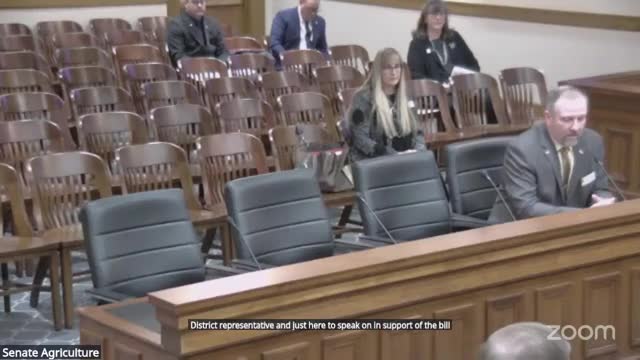Wyoming lawmakers challenge USDA's new livestock identification regulations amid export concerns
January 23, 2025 | Agriculture, State & Public Lands & Water Resources Committee, Senate, Committees, Legislative, Wyoming
This article was created by AI summarizing key points discussed. AI makes mistakes, so for full details and context, please refer to the video of the full meeting. Please report any errors so we can fix them. Report an error »

During a recent meeting of the Senate Agriculture, State and Public Lands & Water Resources Committee, significant concerns were raised regarding new federal regulations impacting livestock identification in Wyoming. The discussions centered around the implications of the USDA's recent edict mandating electronic identification (EID) tags for certain livestock, which has sparked fears of overreach and potential harm to local ranchers.
The Animal Identification Choice Act, passed in 2021, previously allowed Wyoming ranchers to choose from multiple forms of livestock identification, ensuring flexibility in their operations. However, the new regulation requires EID tags for animals over 18 months old that are leaving the state, raising questions about the necessity and fairness of such a requirement. Critics argue that this regulation disproportionately affects export states like Wyoming, where livestock is often raised and processed within state lines without the need for such traceability.
Concerns were voiced about the pressure being placed on veterinarians to comply with the new rules, with some fearing that non-compliance could jeopardize their licenses. This situation has left many ranchers feeling cornered, as they are forced to adapt to regulations that may not apply to their counterparts in other states, such as Texas or Iowa, where livestock may never leave state borders.
The committee members expressed frustration over the lack of a clear rationale for the new requirements, questioning whether they genuinely enhance food safety or merely serve as a regulatory burden. The discussion highlighted a broader concern about the potential for increased government oversight in agricultural practices, with some members suggesting that this could lead to further regulations, such as premises identification, which would require even more stringent compliance measures.
As the meeting concluded, the sentiment among committee members was clear: Wyoming's ranchers deserve a fair and equitable regulatory environment that does not place undue burdens on their operations. The committee plans to continue advocating for the interests of local agriculture and pushing back against regulations perceived as overreaching. The outcome of these discussions will be crucial for the future of livestock management in Wyoming, as ranchers seek to maintain their livelihoods while navigating an evolving regulatory landscape.
The Animal Identification Choice Act, passed in 2021, previously allowed Wyoming ranchers to choose from multiple forms of livestock identification, ensuring flexibility in their operations. However, the new regulation requires EID tags for animals over 18 months old that are leaving the state, raising questions about the necessity and fairness of such a requirement. Critics argue that this regulation disproportionately affects export states like Wyoming, where livestock is often raised and processed within state lines without the need for such traceability.
Concerns were voiced about the pressure being placed on veterinarians to comply with the new rules, with some fearing that non-compliance could jeopardize their licenses. This situation has left many ranchers feeling cornered, as they are forced to adapt to regulations that may not apply to their counterparts in other states, such as Texas or Iowa, where livestock may never leave state borders.
The committee members expressed frustration over the lack of a clear rationale for the new requirements, questioning whether they genuinely enhance food safety or merely serve as a regulatory burden. The discussion highlighted a broader concern about the potential for increased government oversight in agricultural practices, with some members suggesting that this could lead to further regulations, such as premises identification, which would require even more stringent compliance measures.
As the meeting concluded, the sentiment among committee members was clear: Wyoming's ranchers deserve a fair and equitable regulatory environment that does not place undue burdens on their operations. The committee plans to continue advocating for the interests of local agriculture and pushing back against regulations perceived as overreaching. The outcome of these discussions will be crucial for the future of livestock management in Wyoming, as ranchers seek to maintain their livelihoods while navigating an evolving regulatory landscape.
View full meeting
This article is based on a recent meeting—watch the full video and explore the complete transcript for deeper insights into the discussion.
View full meeting